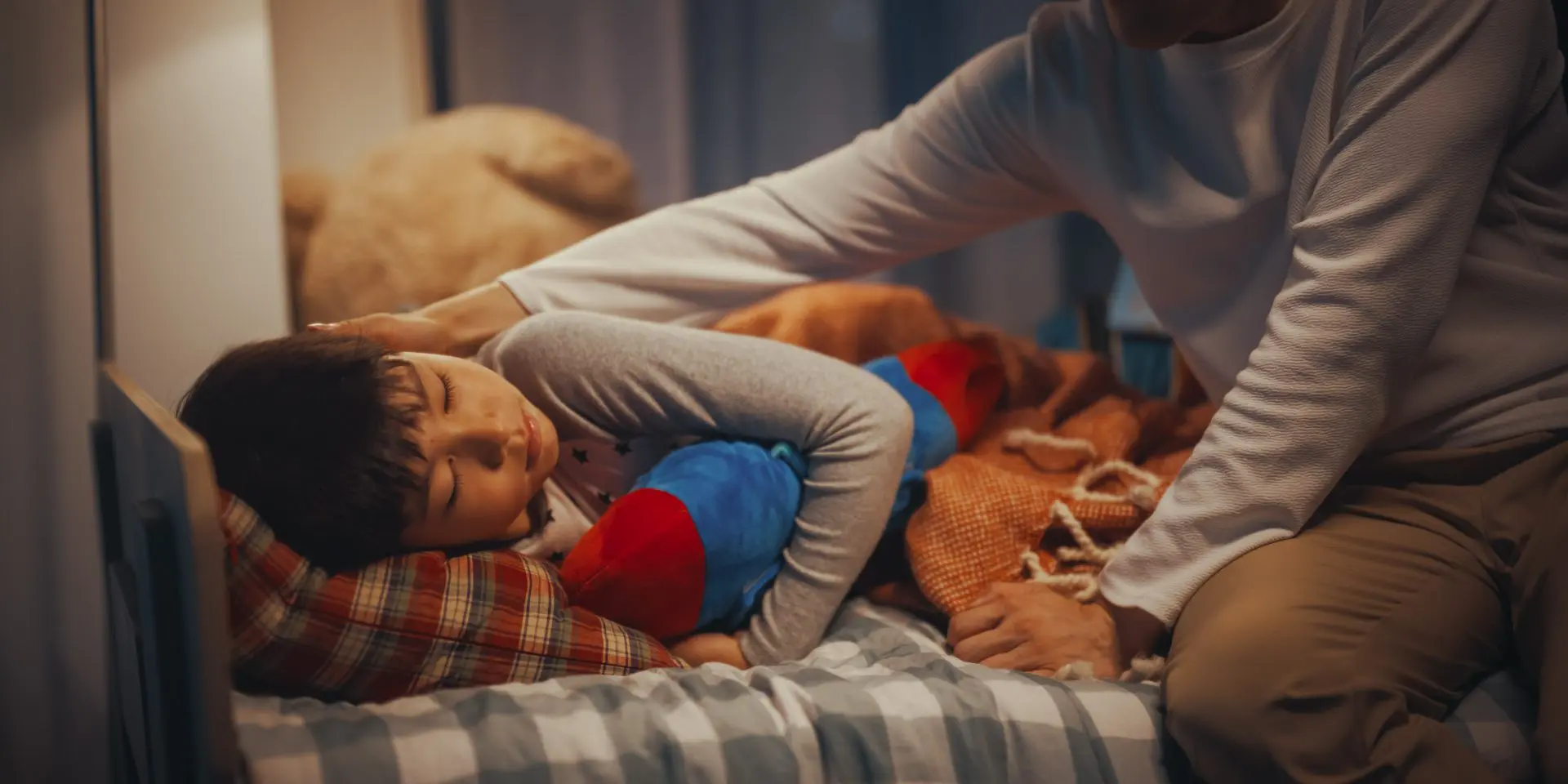Most children will have nightmares at some point in their childhood, this is a normal experience whether they have been bereaved or not. We know that nightmares can stop, happen less often, and begin to feel less frightening.
Nightmares often disturb sleep and can feel scary, confusing, and disorientating for children. It can also be a common experience for the adults supporting a child having nightmares to feel upset themselves by witnessing the child’s distress and to feel physically exhausted. This can also feel additionally difficult if you and other people in your household are also grieving.
After a bereavement, some children struggle to sleep because they are out of their usual daily and bedtime routine and feel unsettled. Getting back into familiar routines during the day and at bedtime may help the child to settle and sleep better.
Try to make the sleep time feel more comforting, safe, and familiar for the child by creating and maintaining a bedtime routine. Your child may like to draw or write it out so that they know what happens next and at each stage, e.g., have a wash, change into pyjamas, brush their teeth, go to the toilet, listen to or read a story, play calming music, have a hug, get tucked up into bed, kiss goodnight.
Ways to help a child settle for sleep:
- Read a calming story or listen to an audiobook together.
- Sing a lullaby, and, if they like physical contact, stroke their hair or hold their hand.
- Listen to soothing music. There are lots of playlists online to choose from. You could also create a calming music playlist together to use at bedtime.
- Use some calming scents such as lavender, perhaps in their soap or a room spray.
- Have something to snuggle up to in bed, e.g., a teddy. Sometimes bereaved children feel comforted by snuggling up to a toy made from some of the clothes of the person who has died as it can help them to still feel close to them. You can also spray the toy with some of the person’s favourite aftershave or perfume, so the smell reminds the child of them.
- Keep a night light on or a lamp left on, or use a sensor light, outside their bedroom if the child may feel more scared in the dark.
- Some children settle better at night if they have a weighted blanket, as they can feel safe and snuggly. Weighted blankets must be used safely, you must check the weight of the child and use only the recommended blanket weight.
- Try some breathing and relaxation techniques. These can be particularly helpful if your child is experiencing worry or fear, as they help the body to calm. There are several free guided breathing exercises online, so you can find one that suits you and your child. Most guided videos count you down and tell you when to breathe in, hold, and slowly breathe out, so they are quite easy to follow.
Sometimes it can be helpful for children to have somewhere else to place their worries to get them out of their heads so they can rest and sleep. Here are a few different ideas to try:
- Hang a dream catcher near their bed. Let them know that this will catch their worries and bad dreams (nightmares) to stop them from entering their thoughts as they dream. Having a dream catcher may help your child to feel safer and protected.
- Write down or draw their worries on paper and place them in a worry box, which can be made from a shoebox. Alternatively, the child could write or draw their worries in a special book. Being able to express themselves before bed may help relieve some of their emotions and make it easier to get to sleep.
- Tell their worries or nightmares to a special toy or a worry doll. Talking to their toy (whether it’s out loud or whispering to them) can help them to express what is on their mind and they can then ask the toy to keep their worries safe whilst they go to sleep.
Providing immediate support after a nightmare:
- Calmly provide verbal reassurance to the child telling them that they are safe. Children often take their cues from the adults around them, so it’s helpful if you can respond in a calm way to soothe them and to reduce their distress. You can also help to re-orientate them back to the here and now by reassuring them, “It’s ok, you’ve had a bad dream, you’re safe, I’m here with you now”.
- You could also use the 5,4,3,2,1 technique to help orientate the child back into the here and now and away from any dream that has caused them upset or distress. This involves encouraging your child to notice where they are now and what is around them in the room now by asking them to name things that they can see, hear, smell, touch/feel, and taste. You could also ask them to name 5 things that are in the room beginning with any letter of the alphabet. These types of activities can help to take their mind off things and calm down again.
- You can offer comfort and care by sharing a hug, offering them a drink, listening to their worries and fears, and staying with them until they calm and/or go back to sleep.
Providing follow up support in the day:
- See if your child can tell you about or draw what happens in their nightmare, so that together you can see if the nightmares are similar each time. It’s easy to assume that the nightmares must be related to the death, but that’s not always the case so it’s important to try and work out what they’re thinking about to know how to try and help.
- Encourage your child to talk about and share any happy and lovely dreams with you too. Falling asleep and dreaming can be a positive experience, so try sharing some fun dreams you have had and ask them to think of any they have had, the idea of having a nice dream may help them feel less afraid of going to sleep at night.
- In the context of bereavement, a child may experience nightmares as they try to make sense of and process the death. It can help to explain the cause of death to the child in a way that they can understand. We know that when children do not know how someone died, they can form their own explanations, which are often worse than the truth. Find out more about how to tell children about a death.
- Support your child to talk or draw or think about how they feel following the death, to share their memories of the person who has died, and to ask any questions can really help them to process their grief. If you are able to talk about these things during the day, the child won’t be bottling up their grief feelings and emotions at nighttime, which may be contributing to ongoing nightmares.
Sometimes children can struggle to go to sleep at night after a bereavement because they may believe that people die when they are asleep. They might worry that when they sleep, they may die too and not wake up again. If your child has heard people say that the person who died has “gone to sleep” or “died in their sleep”, it’s important to explain to them that the person didn’t die because they were asleep, they died because their body stopped working properly. You may want to explain that we all need to sleep so we have energy the next day to play, learn, and have fun, and so our bodies and our minds can keep working well.
If your child has persistent nightmares, causing them significant distress, making it hard for them to function well in the day, we recommend that you discuss this with your GP.
How to get immediate grief support
If you need advice on supporting a bereaved child or young person, you can call the experienced Winston’s Wish team on 08088 020 021 (8am-8pm, weekdays), email us on ask@winstonswish.org or use our live chat (8am-8pm, weekdays).
For out-of-hours mental health support, you can use Shout’s 24/7 messenger service by texting WW to 85258. For urgent support, please call 999.
.

You might also like

Activities
From self-care kits to maintaining memories, download our activities to help a bereaved child or young person cope with their grief.

Book Club
We’ve launched Winston’s Book Club, a series of story books written for children up to 8 years old to help them explore their grief.


